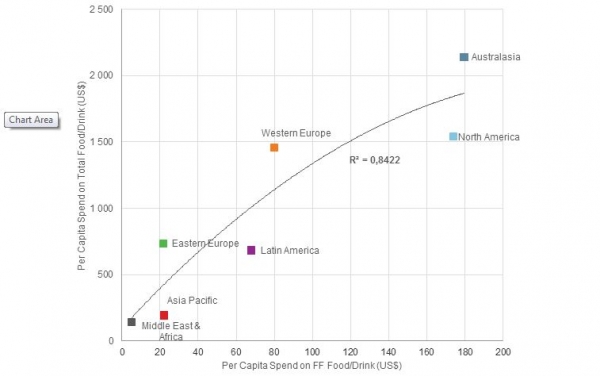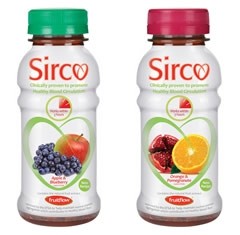What is the functional food magic number? Why, 0.84 of course…

The FF curve quantifies the readiness of consumers in specific regions to buy functional products by correlating per capita spend on food and drink with per capita spend on FF food and drink. With a correlation coefficient – the degree to which the two variables’ movements are associated – of 0.84, there is a clear relationship present.
North America, Australasia and Western Europe have a higher spend on FF food and drink products which offer preventative health measures. It is these regions which will be vital to the success of FF food and drink and on which the focus should be placed to revitalise growth.
Target the ageing population to revitalise growth
There is a real opportunity to prevent a slowdown in growth and hence spend on FF products through innovation. This curve clearly shows that those consumers in the leading regions (Western Europe, North America and Australasia), where the ageing population is rapidly increasing, remain willing to spend on products which offer preventative health measures (and are often more expensive than their conventional counterparts) despite the economic downturn.
Source: Euromonitor International
The ageing population should be the clear stimulus for reinvigorating FF food and drink as despite there being more than 577 million consumers globally aged over 65 in 2012, this demographic remains under-catered for. Even though many consumers are becoming increasingly concerned about the deterioration of their health due to ageing, anti-ageing food and drink products specifically targeting this population remains a niche.
Perhaps the greatest success so far in targeting the ageing population has been achieved through a cardiovascular health positioning. More specifically, Unilever and Raisio have reaped the rewards of the cholesterol-lowering function of plant sterols. Key to their success has been the use of a specific health claim - “plant sterols actively lower cholesterol”.
Products outside cardiovascular health remain minimal
Product launches with other positionings have remained minimal. For example, perhaps one of the biggest concerns for the ageing population is maintaining bone density. However, only two new product launches specifically targeting this audience have been widely marketed. In 2012, Yoplait launched its Calin+ yoghurts fortified with vitamin D and calcium in the UK and France, while in the same year in the US Nestlé launched its BOOST Nutrition Bars, offering 50% of the recommended daily allowance of calcium and 11g of protein. Bone health is not alone - brain health and memory and vision health have performed little better.
Trust in efficacy essential to success
In order for consumers to gain trust in new products claims should be used where the efficacy is realised in a short period of time. As, for many consumers, the specific functional benefits of the ingredients used will be new, utilising these claims will ultimately allow consumers to understand the added value of a product.
For example, Fruitflow, an ingredient that improves blood circulation, is used in the fruit juice brand Sirco. The brand has recently added an additional label to the front of its packaging which states that it works within three hours. The clearly defined efficacy of the functional ingredient has the potential to boost sales of products containing Fruitflow and help it to replicate the success of plant sterols.
Drive growth in emerging markets by communicating added value
In contrast, volume sales will remain the key growth driver of packaged food and drink in regions at the bottom of the curve, such as the Middle East and Africa and Asia Pacific. With much younger populations, manufacturers looking to expand their functional products into these markets will need to effectively communicate their efficacious health benefits and hence added value. If this is done successfully, it can contribute to a region’s more rapid movement up the curve. This can only result in greater returns for manufacturers.











